Surf music
Surf music is a subgenre of rock music associated with surf culture, particularly as found in Southern California. It was especially popular from 1962 to 1964 in two major forms.[8] The first is instrumental surf, distinguished by reverb-drenched electric guitars played to evoke the sound of crashing waves, largely pioneered by Dick Dale and the Del-Tones. The second is vocal surf, which took elements of the original surf sound and added vocal harmonies, a movement led by the Beach Boys.[9][10]
| Surf music | |
|---|---|
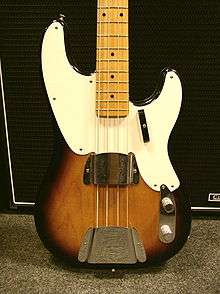 A 1958 Fender Precision Bass guitar. | |
| Stylistic origins | |
| Cultural origins | Late 1950s to early 1960s, United States |
| Typical instruments |
|
| Derivative forms | |
| Subgenres | |
| Fusion genres | |
| Local scenes | |
| |
| Other topics | |
Dick Dale developed the surf sound from instrumental rock, where he added Middle Eastern and Mexican influences, a spring reverb, and the rapid alternate picking characteristics. His regional hit "Let's Go Trippin'" (1961) launched the surf music craze, inspiring many others to take up the approach.
The genre reached national exposure when it was represented by vocal groups such as the Beach Boys and Jan and Dean.[11] Dale is quoted on such groups: "They were surfing sounds [with] surfing lyrics. In other words, the music wasn't surfing music. The words made them surfing songs. ... That was the difference ... the real surfing music is instrumental."[12]
At the height of its popularity, surf music rivaled girl groups and Motown for top American popular music trends.[13] It is sometimes referred to interchangeably with the California Sound.[14] During the later stages of the surf music craze, many of its groups started to write songs about cars and girls; this was later known as hot rod rock.[15]
Instrumental surf
Form
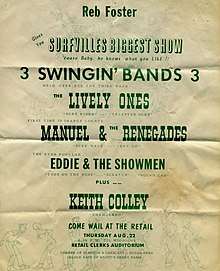
Surf music emerged in the late 1950s as instrumental rock and roll music,[9] almost always in straight 4/4 (or common) time, with a medium to fast tempo. The sound was dominated by electric guitars which were particularly characterized by the extensive use of the "wet" spring reverb that was incorporated into Fender amplifiers from 1961, which is thought to emulate the sound of the waves.[16] The outboard separate Fender Reverb Unit that was developed by Fender in 1961 (as opposed to reverb that was incorporated as a built-in amp feature) was the actual first "wet" surf reverb tone. This unit is the reverb effect heard on Dick Dale records, and others such as "Pipeline" by the Chantays and "Point Panic" by the Surfaris. It had more of a wet "plucky" tone than the "built in" amp reverb, due to a different circuitry.
Guitarists also made use of the vibrato arm on their guitar to bend the pitch of notes downward, electronic tremolo effects and rapid (alternating) tremolo picking.[17] Guitar models favored included those made by Fender (particularly the Jazzmaster, Jaguar and Stratocaster guitars), Mosrite, Teisco, or Danelectro, usually with single coil pickups (which had high treble in contrast to double coil humbucker pickups).[18] Surf music was one of the first genres to universally adopt the electric bass, particularly the Fender Precision Bass. Classic surf drum kits tended to be Rogers, Ludwig, Gretsch or Slingerland. Some popular songs also incorporated a tenor or baritone saxophone, as on the Lively Ones' "Surf Rider" (1963) and the Revels' "Comanche" (1961).[19] Often an electric organ or an electric piano featured as backing harmony.
History
By the early 1960s, instrumental rock and roll had been pioneered successfully by performers such as Link Wray, Nokie Edwards and the Ventures and Duane Eddy.[20] This trend was developed by Dick Dale, who added Middle Eastern and Mexican influences, the distinctive reverb[16] (giving the guitar a "wet" sound),[21] and the rapid alternate picking characteristic of the genre[16] (influenced by Arabic music, which Dale learnt from his Lebanese uncle).[22] His performances at the Rendezvous Ballroom in Balboa, California during the summer of 1961,[23] and his regional hit "Let's Go Trippin'" later that year, launched the surf music craze, which he followed up with hits like "Misirlou" (1962).[16]
While Dick Dale was crafting his new sound in Orange County, the Bel-Airs were crafting their own in the South Bay region of Los Angeles County. The band was composed of five teen-aged boys. At their 1959 origin they were still learning to play their instruments: Dick Dodd on drums, Chas Stuart on saxophone, Jim Roberts on piano, and Eddie Bertrand and Paul Johnson on guitars. Said Johnson of his relationship with Bertrand, "Learning the guitar became a duo experience versus a solo thing. We learned to play by playing together, one guy would play the chords, the other would play the lead. This sound would become the basis for the Bel-Airs."[24] They recorded their first single, "Mr. Moto", in June 1961 (with Richard Delvy on drums instead of Dodd) and the song received radio airplay that summer.[25][26] Dale was older, played louder, commanded a larger audience, and usually gets credit for birthing surf music, but the Bel-Airs lay claim to having the first surf music single.
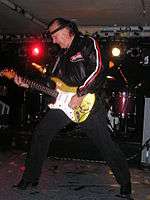
Like Dale and his Del-Tones, most early surf bands were formed in Southern California, with Orange County in particular having a strong surf culture, and the Rendezvous Ballroom in Balboa hosted many surf-styled acts.[23][20] Groups such as the Bel-Airs (whose hit "Mr. Moto", influenced by Dale's earlier live performances,[23] was released slightly before "Let's Go Trippin'"), the Challengers (with their album Surfbeat) and then Eddie & the Showmen followed Dale to regional success.[27]
The Chantays scored a top ten national hit with "Pipeline", reaching number 4 in May 1963. Probably the single-most famous surf tune hit was "Wipe Out" by the Surfaris, with its intro of a wicked laugh; the Surfaris were also known for their cutting-edge lead guitar and drum solos, and Wipe Out reached number two on the Hot 100 in August 1963 and number 16 in October 1966. The group also had two other global hits, "Surfer Joe" and "Point Panic".[28]
The growing popularity of the genre led groups from other areas to try their hand. These included the Astronauts, from Boulder, Colorado; the Trashmen, from Minneapolis, Minnesota, who reached number 4 with "Surfin' Bird" in 1964; and the Rivieras, from South Bend, Indiana, who reached number 5 in 1964 with "California Sun".[16] the Atlantics, from Sydney, Australia, were not exclusively surf musicians, but made a significant contribution to the genre, the most famous example being their hit "Bombora" (1963).[16] Also from Sydney were the Denvermen, whose lyrical instrumental "Surfside" reached number 1 in the Australian charts.[29] Another Australian surf band who were known outside their own country's surf scene was the Joy Boys, backing band for singer Col Joye; their hit "Murphy the Surfie" (1963) was later covered by the Surfaris.[30]
European bands around this time generally focused more on the style played by British instrumental rock group the Shadows. A notable example of European surf instrumental is Spanish band Los Relámpagos' rendition of "Misirlou". the Dakotas, who were the British backing band for Merseybeat singer Billy J. Kramer, gained some attention as surf musicians with "Cruel Sea" (1963), which was later covered by the Ventures, and eventually other instrumental surf bands, including the Challengers and the Revelairs.[31]
Vocal surf
Distinctions
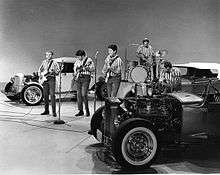
In Matt Warshaw's The Encyclopedia of Surfing, he notes: "Surf music is divided into two categories: the pulsating, reverb-heavy, 'wet'- sounding instrumental form exemplified by guitarist Dick Dale, and the smooth-voiced, multitracked harmonized vocal style invented by the Beach Boys. Purists argue that surf music is by definition instrumental."[32]
This second category of surf music was led by the Beach Boys,[9] a group whose main distinction between previous surf musicians was that they projected a world view.[34] In 1964, the group's leader and principal songwriter, Brian Wilson, explained: "It wasn't a conscious thing to build our music around surfing. We just want to be identified with the interests of young kids."[35] A year later, he would express: "I HATE so-called "surfin'" music. It's a name that people slap on any sound from California. Our music is rightfully 'the Beach Boy sound'—if one has to label it."[36]
Vocal surf can be interpreted as a regional variant of doo wop music, with tight harmonies on a song's chorus contrasted with scat singing.[37] According to musicologist Timothy Cooley, "Like instrumental surf rock with its fondness for the twelve-bar blues form, the vocal version of Surf Music drew many key elements from African-American genres ... what made the Beach Boys unique was its ability to capture the nation's and indeed the world's imagination about the emerging New Surfing lifestyle now centered in Southern California, as well as the subtle songwriting style and production techniques that identify the Beach Boys' sound."[38] In 1963, Murry Wilson, Brian's father who also acted as the Beach Boys' manager offered his definition of surf music: "The basis of surfing music is a rock and roll bass beat figuration, coupled with raunch-type weird-sounding lead guitar, an electric guitar, plus wailing saxes. Surfing music has to sound untrained with a certain rough flavor in order to appeal to teenagers. ... when the music gets too good, and too polished, it isn't considered the real thing."[1]
Hot rod rock
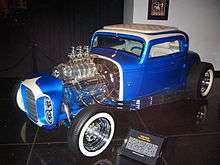
Hot rod music, or hot rod rock, evolved from surf music.[39] Dick Dale recalled surf music was re-imagined as hot rod music by a record company-inspired move to capture a larger market.[40] According to The Ultimate Hot Rod Dictionary by Jeff Breitenstein: "While cars and, to a lesser degree, hot rods have been a relatively common and enduring theme in American popular music, the term hot rod music is most often associated with the unique 'California sound' music of the early to mid-1960s ... and was defined by its rich vocal harmonies, amplified (generally Fender brand) electric guitars, and youth-oriented lyrics (most often celebrating hot rods and, more broadly, surfing and 'girls')."[41]
Author David Ferrandino wrote that "the Beach Boys' musical treatments of both cars and surfboards are identical",[42] whereas author Geoffrey Himes elaborated "subtle" differences: "Translating the surf-music format into hot-rod tunes wasn't difficult. ... If surf music was a lot of Dick Dale and some Chuck Berry, hot-rod music was a little more Berry and a little less Dale—i.e. less percussive staccato and more chiming riffs. Instead of slang about waxes and boards; you used slang about carburetors and pistons; instead of name-dropping the top surfing beaches, you cited the nicknames for the top drag-racing strips; instead of warning about the dangers of a 'Wipe Out', you warned of 'Dead Man's Curve'."[13]
Popularity
In late 1961, the Beach Boys had their first chart hit, "Surfin'", which peaked at number 75 on the Billboard Hot 100, [44] followed by "Surfin' U.S.A." (1963) and "Surfer Girl" (1963) which reached the Top 10.[12] In mid-1962, the group released their major-label debut, "Surfin' Safari". The song hit number 14 and helped launch the surf rock craze into a national phenomenon.[45] Breitenstein writes that hot rod rock gained national popularity beginning in 1962 with the Beach Boys' "409", which is often credited with initiating the hot rod music craze, which lasted until 1965.[41][nb 1] Several key figures would lead the hot rod movement beside Wilson, including songwriter-producer-musician Gary Usher and songwriter-disc jockey Roger Christian.[47]
Wilson then co-wrote "Surf City" (1963) for Jan and Dean, which spent two weeks at the top of the Billboard Top 100 chart in July 1963.[33] In the wake of the Beach Boys' success, many singles by new surfing and hot rod groups were produced by Los Angeles groups. Himes notes: "Most of these weren't real groups; they were just a singer or two backed by the same floating pool of session musicians: often including Glen Campbell, Hal Blaine and Bruce Johnston. If a single happened to click, a group would be hastily assembled and sent out on tour. It was an odd blend of amateurism and professionalism."[13][nb 2] One-hit wonders included Bruce & Terry with "Summer Means Fun", the Rivieras with "California Sun", Ronny & the Daytonas with "G.T.O.", and the Rip Chords with "Hey Little Cobra". The latter two hits both reached the top ten, but the only other act to achieve sustained success with the formula were Jan & Dean.[16] Hot rod group the Fantastic Baggys wrote many songs for Jan and Dean and also performed a few vocals for the duo.[49]
Decline
Like all other rock subgenres of this period, the surf music craze, along with the careers of nearly all surf acts, was effectively ended by the British Invasion beginning in early 1964.[16] Hot rod music also ceased to be prominent that year.[50] The emerging garage rock, folk rock, blues rock and later psychedelic rock genres also contributed to the decline of surf rock.[51] The Beach Boys survived the invasion by diversifying their approach to music.[52] Brian explained to Teen Beat: "We needed to grow. Up to this point we had milked every idea dry ... We had done every possible angle about surfing and then we did the car routine. But we needed to grow artistically."[13] After the decline of surf music, the Beach Boys continued producing a string of hit singles and albums, including the sharply divergent Pet Sounds (1966). Subsequently, they became the only American rock or pop group that could arguably rival the Beatles.[44] The band would only sparingly return to the hot rod and surfing-themed music, beginning with 1968's "Do It Again".[53]
Influence and revival
Instrumental surf rock style guitar was used in the James Bond Theme of the first Bond film Dr. No in 1962, recorded by Vic Flick with the John Barry Seven. The theme became a signature for Bond films and influenced the music of spy films of the 1960s.[54] Surf music also influenced a number of later rock musicians, including Keith Moon of the Who,[16] East Bay Ray of the Dead Kennedys, and Pixies guitarist Joey Santiago.[55] During the mid-to late 1990s, surf rock experienced a revival with surf acts, including Dick Dale recording once more, partly due to the popularity of the movie Pulp Fiction (1994), which used Dale's "Misirlou" and other surf rock songs in the soundtrack.[16] New surf bands were formed, including Arc Isla, Jon and the Nightriders, Man or Astro-man?, the Mermen, Los Straitjackets, and the New Electric Sound. In 2012, Orchestra Nova San Diego premiered "Surf", a symphonic homage to surf music, the ocean, and surfing, by classical composer Joseph Waters.[56]
Revival / Second Wave
Over the short lifespan of surf music in the 1960s a natural separation occurred: the guitar work stood apart from the vocal music, coalescing around a collection of hallmark sounds. This body of guitar work is what is referred to as "instrumental surf" and "surf guitar". In the modern era, the term "surf music" is used specifically to label instrumental surf guitar music.
The book Southern California Surf Music, 1960-1966 was published in 1978. The work was a passion project of guitarist Jon Blair, who had played in a 1960s surf band named the Intruders.[57] Its publication inspired Jon to cajole some friends into recording a few surf tracks onto a 7" vinyl disc in 1979. The EP was discovered by Los Angeles label Bomp! Records who then asked for a complete LP release. Jon and the Nightriders obliged, releasing Surf Beat '80 only a few months later.[58] Jon Blair is usually given credit for birthing the revival of instrumental surf guitar.
During the early 1980s California's coastal cities hosted a small set of bands that all performed traditional surf guitar ("trad"). Big Wednesday was based in Oxnard, Cowabunga in San Francisco, the El Caminos and the Evasions played San Diego, the Surf Raiders formed in Azusa,[59] and Jon and the Nightriders launched out of Riverside. Los Angeles label Rhino Records assembled a studio band and released a pair of albums by the Wedge. They also reunited the Malibooz – a late 1960s surf band from New York – to release an LP of mostly vocal surf music.[60] This wave of traditional surf guitar is referred to as "second wave surf". It dissipated in the mid-1980s, lasting from 1979 to 1986. Jon and the Nightriders disbanded in 1984.
Traditional surf guitar was not the only surf music of the 1980s. Beginning in 1979 Insect Surfers were playing in punk and new wave clubs. Their music was contemporary to the times and not easily classified as surf; they incorporated surf guitar but were not slavish to its traditional sounds. They moved to Los Angeles in 1985 and modified their sound to something more easily classified as surf, but even then it was always adjacent to indie rock and psychedelic rock.[61] Also in 1979, the Raybeats began playing instrumental guitar music with a few surf songs in the mix. For some songs one of their guitarists would swap out for a saxophone or organ to give the music lounge or R&B sounds. They were never a proper surf band but they had influence over surf music.[62] Sometime around 1980 the Halibuts formed. Their line-up included both a saxophone and keyboard and they used these additions to blend surf with ska.[63] San Diego's the El Caminos reinvented themselves in 1983 as the Surf Piranhas, fusing surf with rockabilly.[64] Beginning in 1984, Sweden's the Bottle Ups also mixed surf with rockabilly but with western overtones. The Finnish band Laika & the Cosmonauts broke onto the scene in 1987. Of all the 1980s surf bands their sound was probably the furthest out from trad, with their second album (Surfs You Right, 1990) being their closest to trad but still far from it. At the close of the decade the Mermen formed and issued their first album. Their sound at the time was a fusion of surf and psychedelic rock and they had the feel of a jam band.[65] Both Insect Surfers and the Mermen have been performing ever since.
Third Wave
Surf music was lifted from obscurity and given global attention in 1994 with the release of the movie Pulp Fiction. Dick Dale's 1962 recording of "Miserlou" was the film's title track and played in its trailer. There was other surf music by other surf artists throughout the movie's soundtrack. Surf music, from its birth to its repose and then through its revival, had been consistently niche. While in the 1960s a handful of surf songs made the national playlists, the genre was never a nationwide sensation. Pulp Fiction changed that by placing surf music front and center. After the movie released Dick Dale gained a new audience, touring surf bands had new opportunities, disbanded groups reunited, and new surf bands were minted all around the world. This boom in surf music is known as "third wave surf". It is characterized by the volume of bands that formed, performed, and released surf music at this time. By the end of the decade, most of these bands were disbanded or moved on to other musical styles. The third wave lasted from 1994 to 1999.
Surf punk
Surf punk is a revival of the original surfing sound.[66] It was initiated in the late 1970s and early 1980s by groups such as Forgotten Rebels from Canada – who released "Surfin' on Heroin" in 1981[66] – and Agent Orange from Orange County, who recorded punk cover versions of surf classics such as "Misirlou", "Mr. Moto", and "Pipeline" that same year, with AllMusic's Greg Prato calling the band "influential" and "a step ahead of the rest of the punk/hardcore pack".[67] The genre is related to skate punk, which rose to prominence at the same time, in the Orange County beach towns that nurtured the first wave of surf musicians.[7] Skatepunk band JFA combined the Dead Kennedys' "Police Truck" with the Chantays' "Pipeline" to create the revved-up surf/skate homage "Pipe Truck".[68]
Producers
Herb Alpert played a part in the genre, producing for Jan & Dean.[69] Tony Hilder who owned the Impact label was a prolific surf music producer.[70][71][72] His name as publisher, producer etc., appears on many records, both 45s and albums. If not for the poor crediting on the budget releases his name would have appeared on more.[73] Gary Usher was a producer, arranger and writer. His work included the Surfaris and the Hondells. He also wrote "409" and "In My Room", which were hits for the Beach Boys.[74] Terry Melcher was a producer, noted for his part in shaping the sound of surf music as well as folk. He worked closely with the Beach Boys and was responsible for some of their chart success.[75] Outside Brian Wilson's work with the Beach Boys, one of the acts he produced was Bob & Sheri with their 1962 single, "Surfer Moon".[76]
Notes
- "Little Deuce Coupe" (1963) has been cited by John Milward as one of the earliest forms of hard rock with its series of buzzing beats.[46]
- From 1961 to 1965, some fifteen hundred car songs were recorded.[48] As in the 1950s, many groups adopted the names of car brands, but with a greater emphasis on hot rods, such as the Duece Coupes, the Duals, the GTOs, the Dragsters, the Roadsters, the T-Bones, and the Roadrunners.[48]
References
- Zhefo, Lee (June 29, 1963). "Surfing Craze Ready to Splash Across Country to East's Youth". Billboard. 75 (26). ISSN 0006-2510.
- Sabin 1999, p. 159.
- Marcel Danesi, "Forever young: the teen-aging of modern culture" (University of Toronto Press, 2003), ISBN 0-8020-8620-9, p. 83.
- Besssman (1993), p. 16; Marcus (1979), p. 114; Simpson (2003), p. 72; McNeil (1997), p. 206.
- Bovey, Seth (2006). "Don't Tread on Me: The Ethos of '60s Garage Punk". Popular Music & Society. Routledge. 29 (4): 451–459. doi:10.1080/03007760600787515.
- Sabin 1999, p. 99.
- Perna 2012, p. 117.
- Blair 2015, pp. 7, 49, 119.
- "Surf". AllMusic.
- P. Romanowski, The New Rolling Stone Encyclopedia of Rock & Roll: Completely Revised and Updated (Simon & Schuster, New York, 2nd edn. rev., 1995), p. 973.
- Blair 2015, pp. 7, 49.
- Blair 2015, p. 49.
- Himes, Geoffrey. "Surf Music" (PDF). teachrock.org. Rock and Roll: An American History. Archived from the original (PDF) on 2015-11-25.
- Browne & Browne 1986, p. 194.
- "Hot rod rock". Allmusic. Retrieved 23 April 2011..
- Bogdanov, Woodstra & Erlewine 2002, pp. 1313–1314.
- A. J. Millard, The Electric Guitar (JHU Press, 2004), p. 129.
- T. Wheeler, The Stratocaster chronicles: Fender : celebrating 50 years of the Fender Strat (Hal Leonard, 2004), p. 117.
- R. Unterberger, S. Hicks and J. Dempsey, Music USA: the rough guide (Rough Guides, 1999), p. 382.
- Sabin 1999, p. 158.
- Ian S. Port, "The Birth of Loud: Leo Fender, Les Paul, and the Guitar-Pioneering Rivalry That Shaped Rock 'n' Roll" (Simon and Schuster, 2019), ISBN 1-5011-4176-7, p. 164
- Holgate, Steve (14 September 2006). "Guitarist Dick Dale Brought Arabic Folk Song to Surf Music". The Washington File. Bureau of International Information Programs, United States Department of State. Archived from the original on 2011-10-20. Retrieved 29 August 2010.
- "Rendezvous Ballroom". Huntington Beach International Surfing Museum. Archived from the original on 2011-07-19. Retrieved 13 February 2011.
- "Benefit Show Lends A Hand To Surf Rock Legend Paul "Mr. Moto" Johnson". OCWeekly. Retrieved 6 December 2018.
- "The South Bay Bands that Created the 60's Surf Music Sound". Southbay.
- "They called it surf: 40 years after its peak, genre still rides wave of popularity". The San Diego Union-Tribune. Retrieved 26 September 2004.
- J. Blair, The Illustrated Discography of Surf Music, 1961–1965 (Pierian Press, 2nd edn., 1985), p. 2.
- J. Blair, The Illustrated Discography of Surf Music, 1961–1965 (Pierian Press, 2nd edn., 1985), p. 75.
- "The Denvermen, Sydney, 1961–65", MILESAGO: Australasian Music and Popular Culture 1964–1975, retrieved 18 May 2010.
- Warshaw 2005, pp. 776–777.
- J. Blair, The Illustrated Discography of Surf Music, 1961–1965 (Pierian Press, 2nd edn., 1985), p. 126.
- Warshaw 2009, p. 584.
- Marcus 2013, p. 95.
- Miller 1992, p. 193.
- Nathan & Lindsay 2001, p. 89.
- Beach Boys, The (September 1965). "The Things We LOVE and the Things We HATE". 16 Magazine. 16 Magazine, Inc. 7 (4).
- Edmondson 2013, p. 1117.
- Cooley 2014, p. 56.
- Cozzen 2015, p. 8.
- "SURF COUNTY, USA : No Words Can Describe Real Surf Music". Los Angeles Times. July 27, 1990.
- Breitenstein, p. 107.
- Ferrandino 2015, p. 149.
- Marcus 2013, p. 92.
- Bogdanov, Woodstra & Erlewine 2002, pp. 71–72.
- J. Bush. "The Beach Boys". Allmusic. Retrieved 23 April 2011.
- J. Milward, The Beach Boys Silver Anniversary (Doubleday, 1985), ISBN 0-385-19650-4, p. 48.
- Shuker 2012, p. 279.
- DeWitt, p. 44.
- "The Fantastic Baggys". Allmusic. Retrieved 23 April 2011.
- Ferrandino, p. 149.
- J. Blair, The Illustrated Discography of Surf Music, 1961–1965 (Pierian Press, 1985), ISBN 0-87650-174-9, p. 9.
- Welch, C. (November 14, 1964). "Beach Boys Brought Their Own Vegetables – So Audiences Beware!". Melody Maker: 10.
- Badman, Keith (2004). The Beach Boys: The Definitive Diary of America's Greatest Band on Stage and in the Studio. p. 221.
- K. Spencer, Film and television scores, 1950-1979: a critical survey by genre (McFarland, 2008), pp. 61-70.
- M. Vorhees and J. Spelman, Lonely Planet Boston (Lonely Planet, 3rd edn., 2007). pp. 6 and 34.
- ""Surf" — Swarmius Takes Orchestra Nova To The Beach". San Diego Reader. Retrieved 10 June 2012.
- "John Blair, Surf Guitarist (Interview)". AM FM Magazine.
- "Jon & The Nightriders (1979 to 2001, lead and rhythm guitar, songwriter, producer)". John Blair.
- "a complementary if brief surf raiders bio/overview". rather rare records.
- "The Malibooz". Malibooz.
- "AllMusic Review". AllMusic.
- "AllMusic Review". AllMusic.
- "The Halibuts - Halibut Beach". Reverb Central.
- "Surf Piranhas - Both Sides of Surf". Fat City Cigar Lounge.
- "AllMusic Review". AllMusic.
- Henderson & Stacey 2014, p. 619.
- "Living in Darkness - Agent Orange | Songs, Reviews, Credits". AllMusic.
- "Interview with Brian Brannon of JFA". TX Punk. Archived from the original on March 23, 2012. Retrieved 3 May 2011.
- Rock and Roll, By Maury Dean - Page 297
- The Encyclopedia of Popular Music, Colin Larkin - Page 287
- The Illustrated Discography of Surf Music, 1961-1965, John Blair - Page 102
- The Golden Age of Rock Instrumentals by Steven Otfinoski - Page 140
- Who Put the Bomp, No.14, Fall 1975 - Page 12 "The Tony Hilder Story" by John Blair & Bill Smart
- Los Angeles Times, June 02, 1990 - Gary Usher; Co-Writer of Beach Boys Hits
- The New York Times, November 22, 2004 - Terry Melcher, 62, Creator of Hits in Surf-Music World, Is Dead By Jeff Leads
- Inside the Music of Brian Wilson: The Songs, Sounds, and Influences of the Beach Boys' Founding Genius, By Philip Lambert - Page 53 to 54 OTHER PROJECTS
Bibliography
- Blair, John (2015). Southern California Surf Music, 1960-1966. Arcadia Publishing. ISBN 978-1-4671-3320-3.CS1 maint: ref=harv (link)
- Bogdanov, Vladimir; Woodstra, Chris; Erlewine, Stephen Thomas, eds. (2002). All Music Guide to Rock: The Definitive Guide to Rock, Pop, and Soul. Backbeat Books. ISBN 978-0-87930-653-3.CS1 maint: ref=harv (link)
- Breitenstein, Jeff. Ultimate Hot Rod Dictionary: A-Bombs to Zoomies. MotorBooks International. ISBN 978-1-61059-235-2.CS1 maint: ref=harv (link)
- Cooley, Timothy J. (2014). Surfing About Music. University of California Press. ISBN 978-0-520-95721-3.CS1 maint: ref=harv (link)
- Cozzen, R. Duane (2015). Surf & Hot Rod Music of the 60's: Collectors Quick Reference. Lulu.com. ISBN 978-1-329-40033-7.CS1 maint: ref=harv (link)
- DeWitt, John (2001). Cool Cars, High Art: The Rise of Kustum Kulture. Jackson: University Press of Mississippi. ISBN 9781604737752.
- Edmondson, Jacqueline, ed. (2013). Music in American Life: An Encyclopedia of the Songs, Styles, Stars, and Stories that Shaped our Culture. ABC-CLIO. ISBN 978-0-313-39348-8.CS1 maint: ref=harv (link)
- Ferrandino, David (2015). Turner, Katherine L. (ed.). "This is the Sound of Irony: Music, Politics and Popular Culture". Farnham: Ashgate Publishing: 145–158. ISBN 9781472442611. Cite journal requires
|journal=(help) - Marcus, Ben (2013). Surfing: An Illustrated History of the Coolest Sport of All Time. MBI Publishing Company. ISBN 978-1-61058-761-7.CS1 maint: ref=harv (link)
- Henderson, Lol; Stacey, Lee (2014). Encyclopedia of Music in the 20th Century. Routledge. ISBN 978-1-135-92946-6.CS1 maint: ref=harv (link)
- Miller, Jim (1992). "The Beach Boys". In DeCurtis, Anthony; Henke, James; George-Warren, Holly (eds.). The Rolling Stone Illustrated History of Rock & Roll: The Definitive History of the Most Important Artists and Their Music. New York: Random House. ISBN 9780679737285.CS1 maint: ref=harv (link)
- Nathan, David; Lindsay, Susan Gedutis, eds. (2001). Inside the Hits. Berklee Press. ISBN 978-0-634-01430-7.CS1 maint: ref=harv (link)
- Perna, Alan di (2012). Guitar Masters: Intimate Portraits. Hal Leonard. ISBN 978-1-4803-2970-6.CS1 maint: ref=harv (link)
- Roberts, Jim (2001). How the Fender Bass Changed the World: By Jim Roberts. Backbeat Books. ISBN 978-0-87930-630-4.CS1 maint: ref=harv (link)
- Sabin, Roger (1999). Punk Rock, So What?: The Cultural Legacy of Punk. Routledge. ISBN 0-415-17029-X.CS1 maint: ref=harv (link)
- Shuker, Roy (2012). Horn, David; Shepherd, John (eds.). "Continuum Encyclopedia of Popular Music of the World". 8. New York; London: A & C Black: 279–280. ISBN 9781441148742. Cite journal requires
|journal=(help) - Warshaw, Matt (2005). The Encyclopedia of Surfing. Houghton Mifflin Harcourt. ISBN 0-15-603251-1.CS1 maint: ref=harv (link)
Further reading
- Chidester, Brian; Priore, Domenic (2008). Pop Surf Culture: Music, Design, Film, and Fashion from the Bohemian Surf Boom. Santa Monica Press. ISBN 978-1-59580-035-0.CS1 maint: ref=harv (link)
- Miller, Chuck (2011). Warman's American Records. Krause Publications. ISBN 1-4402-2821-3.CS1 maint: ref=harv (link)
- Valdez, Stephen K. (2006). A History of Rock Music. Kendall/Hunt Publishing Company. ISBN 978-0-7575-3379-2.CS1 maint: ref=harv (link)